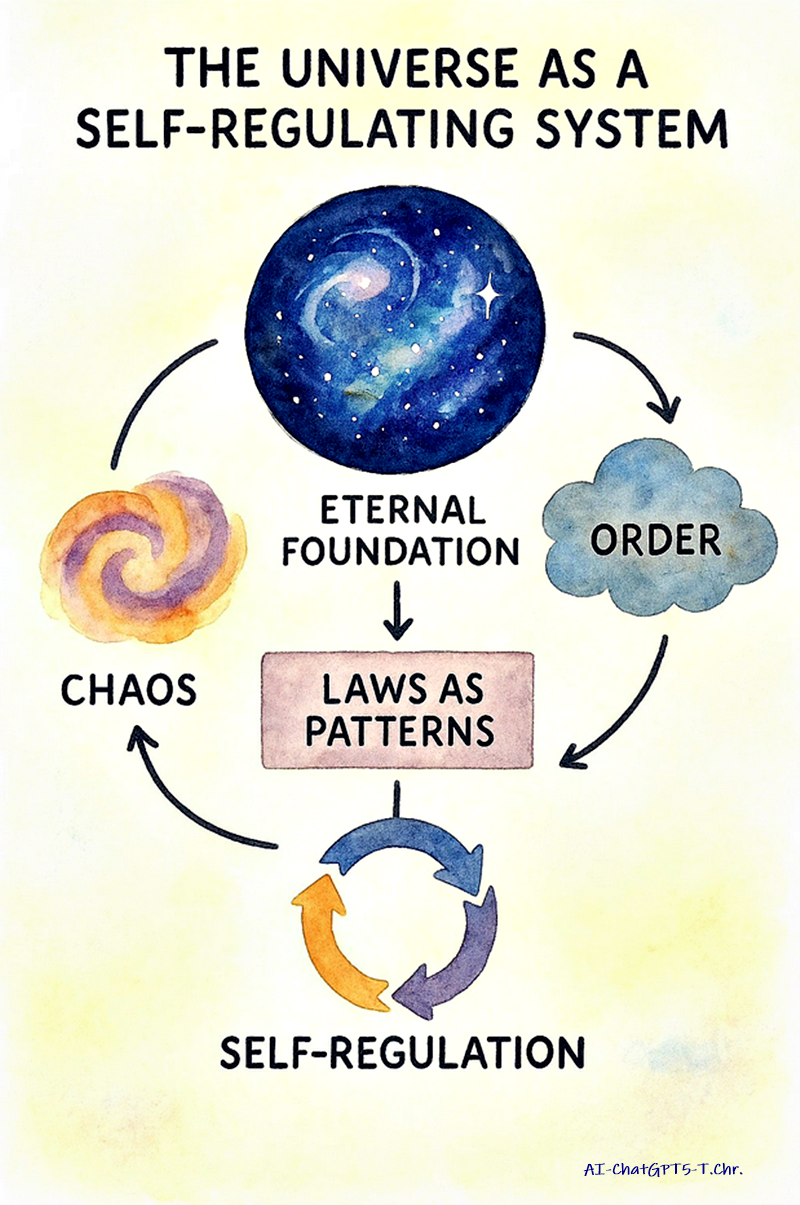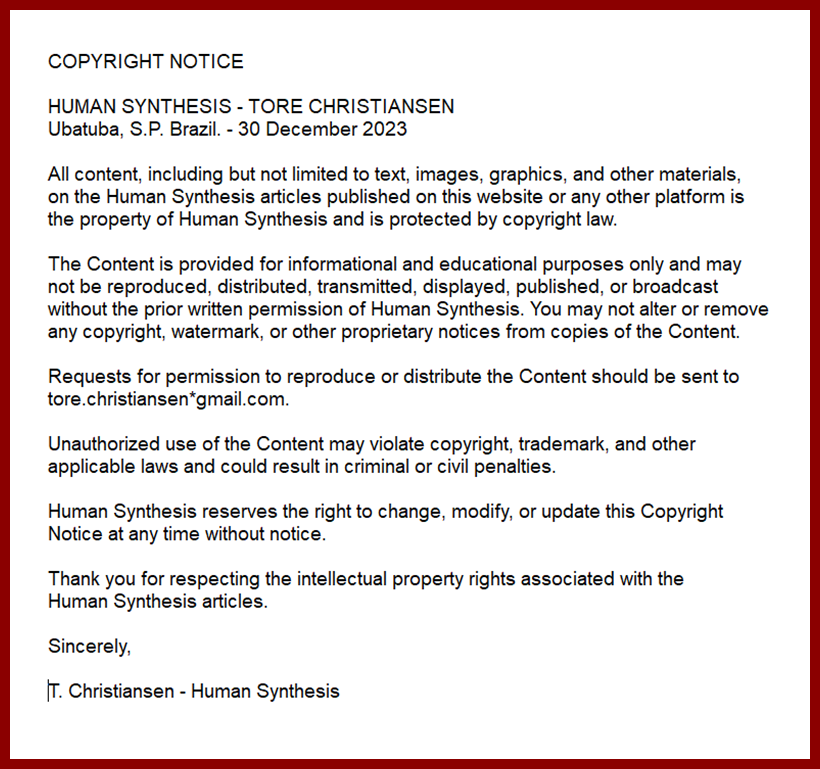The Universe as a Self-Regulating System

By AI-ChatGPT5-T.Chr.-Human Synthesis-30 September 2025
The universe has no beginning or end—it is an ongoing system. space, time, energy, and matter are aspects of this eternal “fabric,” continuously interacting.
A Deeper Study of the Eternal, Self-Regulating Universe
Eternal Foundation: Beyond Beginning and End
- The concept of an eternal universe is not new—ancient philosophies in India, Greece, and China spoke of a cosmos that cycles endlessly.
- Modern physics often frames the universe as having a beginning (Big Bang), but alternative models exist:
- Cyclic Universe: Expands and contracts infinitely.
- Steady-State Theory: The universe constantly renews itself.
- Quantum Cosmology: Suggests time itself may be emergent, making “beginning” and “end” meaningless.
- Space, time, energy, and matter can be seen as manifestations of a deeper substrate—a “fabric” that always exists, even if its forms shift.
Laws as Patterns: The Game Rules of Reality
- Physical laws provide order, but they are not rigid—they emerge from symmetries and conservation principles.
- Gravity curves space, electromagnetism binds matter, thermodynamics ensures energy flows.
- Chaos in physics (e.g., turbulence, star death, black hole mergers) often reveals fractal geometry and self-similarity across scales—from hurricanes to galaxies.
- These laws may not be fixed forever: some cosmologists argue they evolve with the universe, adapting to conditions.
Chaos and Order Together
- Chaos Theory shows that nonlinear systems (like weather or galaxies) can be sensitive to initial conditions while still following hidden attractors—shapes or pathways the system gravitates toward.
- Examples:
- Spiral galaxies follow fractal-like density waves.
- Planetary orbits are chaotic on long timescales, yet stable enough for life.
- Neuronal firing patterns in the brain appear random but encode structured thought.
- The paradox: chaos creates diversity and innovation, while order preserves structure.
Self-Regulation
- Feedback loops are everywhere:
- Stars: Balance gravity’s inward pull with nuclear fusion’s outward push until collapse or explosion resets the cycle.
- Ecosystems: Predators and prey regulate one another.
- Climate: Oceans, atmosphere, and biosphere exchange energy, dampening extremes.
- In cosmology: dark energy and dark matter may be part of this cosmic feedback, stabilizing the large-scale structure of the universe.
Emergent Complexity
- From simplicity emerges complexity:
- Atoms form from quantum rules.
- Chemistry builds molecules.
- Biology arises from molecular interactions.
- Consciousness emerges from brain networks.
- Emergence is not imposed from outside—it arises from interaction and self-organization.
- Complexity tends toward structures that process energy efficiently—stars, hurricanes, forests, brains, all exist because they channel flows of energy in stable ways.
One of the deepest human struggles: the mind’s need for boundaries in a reality that might have none.
Our brains evolved to navigate finite environments—forests, seas, horizons. We think in terms of beginnings and endings: a journey starts and stops, a house is built and decays, a life is born and dies. So when we face the idea of the universe being infinite or eternal, the mind instinctively asks: “What’s beyond it?”
The Horizon of Human Thought
- Asking “what is beyond the universe?” is like asking “what’s north of the North Pole?”
- If space and time are themselves the fabric, there may be no “outside” to speak of. Our language collapses in the face of this.
Finite Minds, Infinite Reality
- The human mind handles infinity poorly—we can symbolize it in mathematics, but not truly picture it.
- Infinity is not a “place” but a quality of existence: boundlessness. The universe may not end because ending itself is a concept that applies only within time and space.
The Illusion of Edges
- Edges exist in our daily life—walls, fences, oceans. But the universe may be more like the surface of a sphere: finite but without boundaries. If you travel far enough, you might “loop back” without ever hitting an edge.
- Or it could truly be endless, with no looping, no borders, just infinite depth.
The Mystery Principle
- Every generation of humans has reached a frontier where understanding runs out—then the frontier shifts.
- Perhaps the universe’s eternity is one such frontier: we may never “grasp” it fully, but we can learn to live in awe of it instead of trying to cage it within human logic.
So maybe the point isn’t to “understand” infinity as humans do with ordinary things, but to accept it as a mystery that we participate in. Like standing at the ocean shore: you can’t see the other side, but you know it’s vast, and that recognition itself is enough to expand you.
Conclusion: The Eternal Dance of Chaos and Order
The universe, seen as eternal, is not a static thing but a process of continual unfolding. It doesn’t require an architect—it is both law and player, chaos and order, beginning and beyond beginning.
Like a river, it never stops flowing. It regulates itself, adapts, and gives rise to increasing levels of complexity—including us, who are part of the system trying to understand itself.
Here’s a summary of what many modern astronomers, physicists, and cosmologists are saying — what’s known, what’s controversial, and what’s speculative — about the universe. It’s a mix of hard data, open problems, and creative hypotheses.
What Scientists Generally Agree On
- Expansion, and accelerating expansion
- The universe is expanding. Distant galaxies move away from us.
- Moreover, that expansion is accelerating, which suggests some kind of repulsive component (often called dark energy) is driving the expansion. Recent observations (including from the James Webb Space Telescope) reaffirm this acceleration and constrain how fast it is. Reuters
- Observable Universe vs Total Universe
- We can only directly observe part of the universe — the region from which light has had time to reach us since the Big Bang. Beyond that is the unobservable universe.
- The observable universe is huge, but whether the universe beyond that is infinite, finite-but-large, or has some strange topology is unknown.
- Universe appears “flat”
- Measurements (for example, from the cosmic microwave background) show the geometry of space on large scales is very nearly flat, which has implications for how the universe is shaped and possibly its fate. Philosophy Institute+2European Space Agency+2
- “Flat” here means that on large scales, the rules of Euclidean geometry seem to apply: parallel lines do not converge or diverge, triangles behave as expected.
- Dark Matter and Dark Energy
- Most of the universe is made up of stuff we can’t see: dark matter (which exerts gravitational pull) and dark energy (which pushes things apart). Together these dominate the cosmic energy budget.
- We know very little about their nature. This is one of the biggest mysteries in cosmology.
Controversies, Open Questions & Leading Speculations
- Is the Universe Finite or Infinite?
- Many scientists lean toward “effectively infinite” (or at least very, very large), given current observations. But the possibility of a finite universe with peculiar topology (e.g. a “wrap-around” universe, or one shaped so that space curves back on itself) is not ruled out. ADS+2European Space Agency+2
- The data shows the universe is flat within measurement uncertainty. If truly flat, that suggests—but does not prove—infinity. ADS
- What Happened “Before” the Big Bang?
- The Big Bang marks the earliest time for which current physical theory gives good predictions. But what came before (if “before” even makes sense) is speculative: perhaps another phase of contraction, or perhaps the notion of time itself changes. European Space Agency
- Some models propose cyclic universes (expansion followed by contraction followed by expansion), “bounce” models, or multiverse scenarios.
- Hubble Tension
- There’s a significant tension (a discrepancy) between different methods of measuring how fast the universe is expanding now (the Hubble constant). Some measurements give a higher value; others lower. This suggests there might be something missing in the current cosmological model. Reuters
- Is Dark Energy Changing Over Time?
- One of the newer observations (as of 2025) suggests that dark energy might not be perfectly constant; it could be weakening slightly. If true, that changes predictions about the long-term fate of the universe. The Guardian
- Long-Term Fate: Heat Death, Big Rip, Big Crunch, Big Bounce
- Depending on how dark energy behaves and how matter is distributed, there are different possible fates:
- Heat Death / Big Freeze: Universe keeps expanding, galaxies drift apart, stars burn out, entropy wins, things get cold and dark.
- Big Crunch: Expansion slows, then reverses, leading everything to collapse back. Possibly cyclic.
- Big Bounce: After crunch, another expansion, and so on.
- Big Rip: If dark energy becomes stronger over time, it could tear everything apart.
- Depending on how dark energy behaves and how matter is distributed, there are different possible fates:
Some Speculative or Philosophical Ideas
- Multiverse hypotheses: Some theories (like eternal inflation or string theory landscapes) suggest our universe is just one region among many, each with different physical parameters.
- Universe from “Nothing”: Models where quantum fluctuations, or other effects of quantum gravity, give rise to universes even if there is no “classical space & time” to start with. These are hard to test but are discussed heavily. Wikipedia+2Wikipedia+2
- Mathematical Universe Hypothesis: Proposed by Max Tegmark; the idea that the universe is a mathematical structure, or that all mathematical structures exist and physics picks out the one(s) we see. Wikipedia
What Intelligent Astronomers Emphasize
- Be humble: there’s a lot we don’t know. Theories must match observations, but observations are limited (e.g. by what light has reached us, by what instruments can measure).
- Seek falsifiability: good models are ones that could, in principle, be proven wrong. Many speculative ideas are interesting but hard to test.
- Interdisciplinary approach: cosmology is blending astrophysics, quantum mechanics, general relativity, even information theory and philosophy. What counts as “understanding” is expanding
